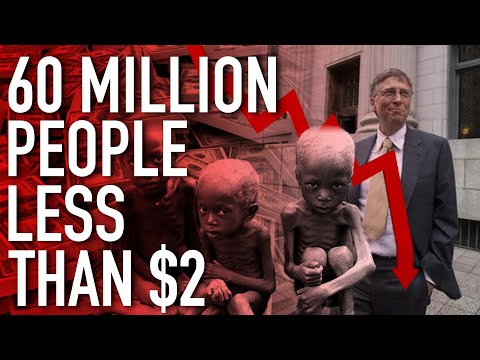https://www.youtube.com/watch?v=qm39nq9VrSs
As the pandemic shows no signs of slowing and government responses fail to adequately address the economic collapse, devastating new data shows the cold, hard reality that citizens worldwide will be forced to accept as the new normal. As a result of the present, and worsening, financial collapse, the World Bank estimates that up to 60 million people across the globe could be pushed into “extreme poverty.”
By definition, individuals living in extreme poverty survive on only $1.90 a day, a task that seems hardly feasible. This estimate is up from a previous figure released by the same institution on April 20, which predicted 49 million people would be affected. That means that in a little over a month, an additional 11 million individuals have seen their futures turn bleak. There is no telling how high that number may rise in the weeks and months to come.
In this video, we’ll explain just what the World Bank Group is and what it is doing to fight back against the pandemic-induced financial crisis now facing the planet. We are going to show you the stark reality facing millions across the globe, particularly in vulnerable developing countries where access to basic human needs like food, water, and healthcare is already precarious.
The World Bank is an international financial institution designed to fight global poverty by providing loans and grants to the governments of poorer countries. These loans are intended for infrastructure and development projects. Already, the World Bank has devoted $160 billion to efforts to soften the blow of the economic collapse on at risk populations.
Despite such massive spending, according to World Bank Group President David Malpass, the current situation and the forecasts for how bad things will get could virtually erase decades of positive work towards poverty alleviation in developing countries, which hold a majority of the world’s population.
“The World Bank Group has moved quickly and decisively to establish emergency response operations in 100 countries, with mechanisms that allow other donors to rapidly expand the programs,” he said. “To return to growth, our goal must be rapid, flexible responses to tackle the health emergency, provide cash and other expandable support to protect the poor, maintain the private sector, and strengthen economic resilience and recovery.”
39 of the 100 countries that World Bank is engaged with are in Sub-Saharan Africa, often in unstable locations that suffer from ongoing conflict. This region of the world is likely to be hit the hardest by the economic collapse. In fact, 23 million of the 60 million people estimated by the World Bank to be pushed into extreme poverty would be located there. These tens of millions of people could lose access to even the most basic necessities of life.
“We cannot afford to stand idly by and hope this most viral and deadly of diseases bypasses Africa, which is home to many of the world’s poorest countries who are simply not in position to handle such a pandemic,” said UN High Commissioner for Human Rights Michelle Bachelet and Chairperson of the African Commission on Human and Peoples’ Rights Solomon Dersso.
South Asia, with its dense populations and widespread poverty, will also suffer. World Bank economists estimated last month that India, the second most populous country in the world after China at over 1.6 billion citizens, will experience “the largest change in the number of poor.” They predicted that about 12 million will be affected. In wider South Asia, the number expected to fall into extreme poverty hits 16 million.
Nigeria and the Democratic Republic of Congo are also among the countries likely to experience the most dramatic shifts in inequality, with 5 million and 2 million people expected to fall into extreme poverty, respectively. Countries like China, South Africa, and Indonesia are also forecasted to have over one million people pushed into extreme poverty as a consequence of the pandemic and the associated financial crisis.
Furthermore, when examining higher poverty lines, “for example the number of people living on less than $3.20 or $5.50 per day, more than 100 million people will be pushed into poverty. Latin America and the Caribbean, East Asia and the Pacific and the Middle East and North Africa are all expected to have at least 10 million more people living on less than $5.50 per day,” the World Bank predicted.
Previously, global poverty—the share of the world’s population living on less than $1.90 per day—was projected to decrease from 8.1 percent to 7.8 percent from 2019 to 2020. Now, that figure is projected to increase to 8.6 percent or higher this year.
“In the more pessimistic scenarios, global poverty in 2020 would be close to the level in 2017, meaning that the world’s progress in eliminating extreme poverty would be set back by three years,” the World Bank wrote.
Επιλεξτε να γινετε οι πρωτοι που θα εχετε προσβαση στην Πληροφορια του Stranger Voice





